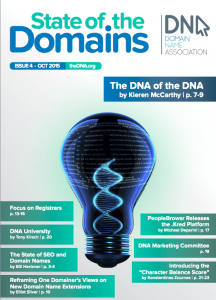 This is my first article that has been published in the traditional style: in a paper magazine. The magazine is called State of the Domains and is published by the Domain Name Association.
This is my first article that has been published in the traditional style: in a paper magazine. The magazine is called State of the Domains and is published by the Domain Name Association.
I would like to thank the Domain Name Association (DNA) for giving me this opportunity and especially Simon Cousins that is the issue editor and co-founder and CEO of Allegravita LLC.
My article is published on issue 4 of the DNA State of the Domains magazine that is on a 500-copy print run and is being distributed at ICANN 54 conference in Dublin Ireland that started yesterday.
The article is something I have been thinking since New gTLGs first came out and have been working on the data for a few months now. I hope you enjoy it. As always I welcome all comments and requests for future work.
Introduction
The purpose of this article is to analyze the number of characters left and right of the dot of all public end-user New gTLD domain name sales made by both registries and resellers. The data can help New gTLD registries identify what domain names to reserve or price as premium. Domain name investors can identify what domain names to purchase for resell and what domains to drop from their portfolio.
Legacy gTLDs (.com, .net, .org) initially had a standard length of 3 characters. The introduction of some gTLDs, such as .biz and .info, in 2001 didn’t change much except add a single character to just one gTLD (.info) and bring the maximum character length to the right of the dot to 4. ccTLDs had and still have a fixed length of 2 characters corresponding to ISO 3166-1 alpha-2 country codes.
This standard and almost fixed length of TLDs brought the focus to the left of the dot where short domains are considered more valuable. Enter January 2014 and New gTLDs were released. New gTLDs have a minimum length of 3 characters (.xyz, .nyc, .law) but have no maximum length and range up to 13 characters for non-brand New gTLDs (.international).
Methodology
The research was based on the 765 sold New gTLD domains that are currently in the Sold.Domains database. From these 765 domains, the wholesale (registry to reseller, reseller to reseller) domain name sales were removed and that also took out most of the registry, reseller and expired auctions.
The reseller market is not always a good marker of what end-users want and purchase. The registry to reseller and reseller to reseller market is often drove by short names (1-3 characters), numbers, and other domains perceived as highly desired and premium. Often the same domains are traded many times in a short period of time and that skews the results.
That left us with about 400 sold domains most of which were provided by Sedo, the .Club registry and private sales.
Results
We first looked at the right of the dot because this is totally new data. One would expect that 3 character New gTLDs would rule domain name sales but that is not the case. 4 character TLDs are the most popular followed by 5,6,7 and then 3 character TLDs. Even if we take out .club that has more than 100 sales, 4-character TLDs are still in the lead. TLDs with 10 characters or more are very difficult to sell.
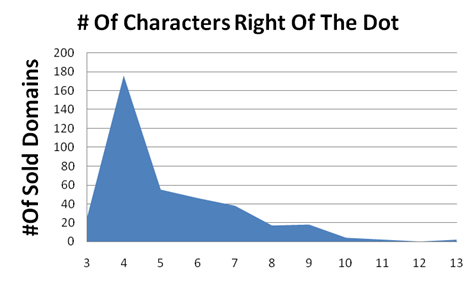 Then we looked at the number of characters to the left of the dot, the second-level domain (SLD) name. 4 characters are leading the chart followed by 3,5,6 and 7 character domain names. People often say that shorter is better but that is not the case with New gTLDs. 2 character domains were just released so we don’t have much data but 1 character domains have been available from Donuts since January 2014 and no significant number of sales has been recorded. It seems that buyers and especially end-users are not looking for acronyms but words that complement the New gTLD string. They are looking for left.right combinations that have a meaning. Any domain with 14 and more characters to the left of the dot is very difficult to sell. Sales of 2-word domains are very few and rare. Less than 5% of the sales have 2 words on the left of the dot. The number of characters includes letters, numbers and hyphens.
Then we looked at the number of characters to the left of the dot, the second-level domain (SLD) name. 4 characters are leading the chart followed by 3,5,6 and 7 character domain names. People often say that shorter is better but that is not the case with New gTLDs. 2 character domains were just released so we don’t have much data but 1 character domains have been available from Donuts since January 2014 and no significant number of sales has been recorded. It seems that buyers and especially end-users are not looking for acronyms but words that complement the New gTLD string. They are looking for left.right combinations that have a meaning. Any domain with 14 and more characters to the left of the dot is very difficult to sell. Sales of 2-word domains are very few and rare. Less than 5% of the sales have 2 words on the left of the dot. The number of characters includes letters, numbers and hyphens.
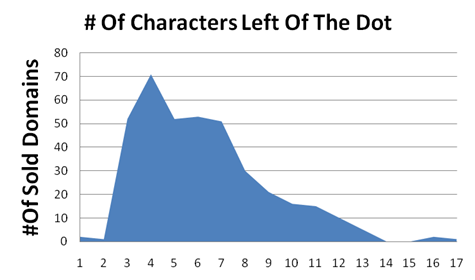 Finally we looked that the total number of characters of both left and right of the dot. Very short (4 to 6 characters) domains are not selling. At least not yet because this might change in the future. Most sales occur between 7 and 16 characters in total. Any domain that has a total of 20 or more characters in not easy to sell. Of course every rule has its exception. It doesn’t mean that a domain name that has 25 characters in total will never sell. It could sell but it is going to be one in a thousand sales.
Finally we looked that the total number of characters of both left and right of the dot. Very short (4 to 6 characters) domains are not selling. At least not yet because this might change in the future. Most sales occur between 7 and 16 characters in total. Any domain that has a total of 20 or more characters in not easy to sell. Of course every rule has its exception. It doesn’t mean that a domain name that has 25 characters in total will never sell. It could sell but it is going to be one in a thousand sales.
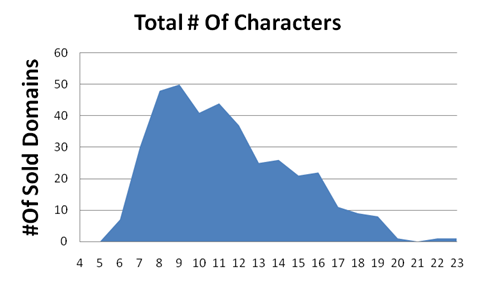 Introducing the “Character Balance Score”
Introducing the “Character Balance Score”
The advent of New gTLDs makes us introduce a new term: the Character Balance Score or CBS. It seems that the balance between left and right of the dot, that the New gTLDs can offer, is desirable by the domain name buyers. In legacy TLDs, such as .com, a perfect balance is found in 3 letter domains. (abc.com) That is one of the reasons they are so valuable.
The Character Balance Score is the character difference between the SLD and the TLD. e.g. home.guru has a 0 CBS, homes.guru has a +-1 (or 1) CBS.
A CBS of +-1 is leading the chart followed by 0 and 2. When you reach a CBS of 6 the chart drops significatly.
In legacy TLDs (.com) the most common CBS in domain name sales is 6. (A random Sedo domain name sales report was used) This means that the most common SLD length is 9. There is a difference of 5 in CBS between New gTLDs and legacy TLDs. So buyers are seeking more balanced domain names in New gTLDs. Less balanced domain name will be harder to sell.
The main problem of this research was the lack of data. More domain name sales would give better results. But the New gTLD program is fairly new and an aftermarket for such domains is just starting to shape. Some registries, except .club, are reporting little to no sales. Furthermore GoDaddy and Afternic are not reporting domain name sales since the summer of 2014.
Most registries, except Donuts, have not released any 1-2 character domains. 2 character domain names were just released by Donuts. Some 2-character domains are still reserved by ICANN.
Domain name character length almost certainly has some price correlation that will be researched in a future article.
Download the latest DNA State of the Domains Issue 4 (pdf download edition) here.
 OnlineDomain.com Domain Name News & Opinions
OnlineDomain.com Domain Name News & Opinions

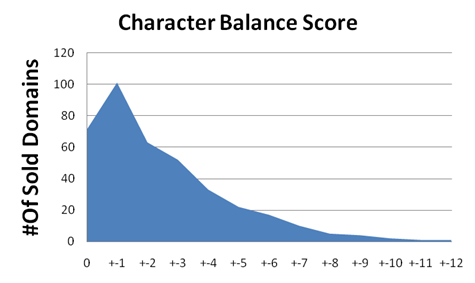

 OnlineDomain.com - © Copyright 2012-2025 - All Rights Reserved
OnlineDomain.com - © Copyright 2012-2025 - All Rights Reserved
Glad to see these questions being analyzed. There are aspects to the study a person might critique. But given how limited the data is and how numerous the complicating factors, I think it’s best to be grateful someone is taking a look. Future studies can learn from this one.
Interesting to think about “Character Balance”.